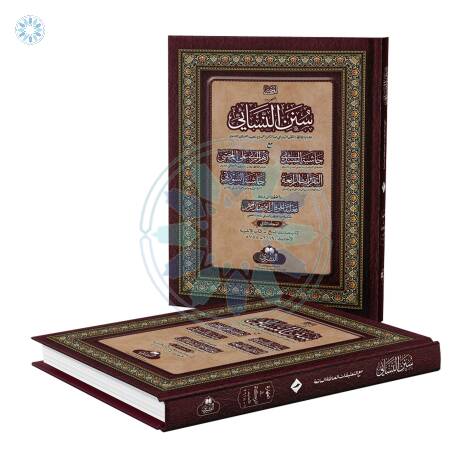Sunan Al-Nasa’i
Sunan an-Nasā'ī is a collection of hadīth compiled by Imām Aḥmad an-Nasā'ī (rahimahullāh). His collection is unanimously considered to be one of the six canonical collections of hadith (Kutub as-Sittah) of the Sunnah of the Prophet ( ). It contains roughly 5700 hadīth (with repetitions).
). It contains roughly 5700 hadīth (with repetitions).
About The Author
Aḥmad ibn Shu`ayb ibn `Alī ibn Sīnān Abū `Abd ar-Raḥmān al-Nasā'
Aḥmad ibn Shu`ayb ibn `Alī ibn Sīnān Abū `Abd ar-Raḥmān al-Nasā'ī (214 - 303 AH/ ca. 829 - 915 AD/CE), was born in the year 214 A.H in the famous city of Nasa, situated in Western Asia known at that time as Khurasan which was a famous centre for Islamic knowledge where many Ulama were situated and studies in hadith and fiqh were at its peak. He primarily attended the gatherings and circles of knowledge in his town where he specialized in his study of hadith. When he was 20 years old, he started travelling and made his first journey to Qutaibah. He covered the Arabian Peninsula seeking knowledge from the Ulama and Muhadditheen of Iraq, Kufa, Hijaz, Syria and Egypt. Finally, he decided to settle in Egypt.
Memory, Piety, and other qualities:
He was a man full of taqwa and he possessed a photographic memory too. The famous scholar and commentator of the Holy Qur'an Al-Dhahabi would say narrating from his teachers that this Great Imam was the most knowledgeable in Egypt. The Great Imam would put on good clothing according to the Sunnah of our beloved Prophet Muhammad pbuh and would eat poultry every day with nabeedh acting on the Sunnah so that he could worship Allah with ease. In fact, it is narrated that the man would fast every other day which is classified in the hadith as the fast of Dawud (as) he would worship Allah continuously throughout the nights and teach Hadith throughout the day. The Imam would also perform Hajj nearly every year and would also take part in Jihad. He was a truthful man.
Teachers and Students:
Imam an-Nasa'i studied from many teachers, the famous ones are: Ishaq ibn Rahweh, Imam Abu Dawud Al-Sijistani (author of Sunan Abu Dawud) and Qutaibah ibn Saeed. After the Imam had decided to stay in Egypt he started to lecture, mostly narrating ahadith to the extent that he became famous by the title Hafidhul Hadeeth. Many people would attend his gatherings and many famous Great Scholars became his students and notably the most famous ones are:
• Imam Abul Qasim Tabarani
• Imam Abu Bakr Ahmed ibn Muhammad also known as Ibn as-Sunni.
• Sheikh Ali, the son of the famous Muhaddith, Imam Tahawi.
It is also narrated that Imam Tahawi personally narrated from this Imam.
Muqallid or Mujtahid
Imam an-Nasa'i was a follower of the Shafi'i Fiqh according to many scholars. Some other scholars consider him to be a Hanbali and Sheikhul Islam ibn Taymiyyah has also stated this. It is likely that he was a Mujtahid more inclined towards the Hanbali Fiqh but many a time would differ from the Hanbali scholars.
His Works
The great Imam also left behind many beneficial works, many of which unfortunately are not published but we can without any doubt conclude from what we have understood that his knowledge and excellence is no less than that of Imam Bukhari and ibn Hazm.
These are a few of his famous works:
- Sunan Al-Kubra
- Sunan Al-Sughra/Mujtana/Al-Mujtaba (popular today as Sunan an-Nasa'i)
- Amul Yawmi Wallaylah
- Kitaby Dufai wal Matrookeen
- Khasais Ali
- Al-Jarhu wa Ta'adeel
His famous book is known as Sunan al-Nasa'i which is taught around the world in every Islamic institute and which possesses the virtue of being one of the Kutub Sittah (the six books generally taught in hadith). In reality, when the Imam had finished compiling Sunan Al-Kubra he presented to the governor of Ramallah so the governor asked him “Is it all sahih?” He replied in the negative, thus the governor suggested and requested that he compile another book and gather in there the Sahih Hadith. So then he did this and named his book Sunan Al-Sughra (the small Sunan) and Al-Mujtaba and Mujtana (both mean carefully chosen) and this is the Sunan which we know as Sunan An-Nasa'i. In this book, he follows the footsteps of Imam Muslims and Imam al-Bukhari (R.A). Overall most of the ahadith are Sahih and where he narrates a weak narration he clearly clarifies the weakness. Thus it is 3rd in number in the Kutub Sittah after Bukhari and Muslim according to some Ulama' because of its Sahih narrations. He clearly clarifies the hard words and brings different narrations for particular ahadith as Imam Muslims does.
His Death:
Controversies arose between the Khawarij (who cursed Ali and revered Muawiya) and the khutbas of Imam an-Nasa'i, he was tortured and forced to move from Palestine to Egypt. In Egypt, his trials did not stop and he was persecuted further. From Egypt, he intended to go to Makkah but as he arrived in Makkah he passed away at the age of 88 on Monday 13th of Safar 303 AH in the holy city near the Ka'ba and he was buried between Safa and Marwa. Ibn Hajr and adh-Dhahabi state that he passed away in Ramallah, Palestine during the journey to Makkah and the body was sent to Makkah and buried between Safaa and Marwa.
About The Publisher
Maktabatul Bushra
Al Bushra Welfare & Educational Trust is a non-profitable, multilingual Islamic Publishing House. Their publications include the Holy Quran and its translations, books related to Dars-e-Nizami, and myriad Islamic works. Their publications are not merely confined to English and Urdu, in fact, they have published books written in Arabic, Spanish, German, French etc. All these works highlight different aspects of sacred learning and have been penned by genuine and enlightened Muslim scholars.
Additional Product Information
- ISBN 13: MB0148
- ISBN 10: MB0148
- ISBN: MB0148
- SKU 1: TISSAN
- SKU 2: TIS
- Author: Aḥmad ibn Shu`ayb ibn `Alī ibn Sīnān Abū `Abd ar-Raḥmān al-Nasā'
- Edited and illustrated By:Aḥmad ibn Shu`ayb ibn `Alī ibn Sīnān Abū `Abd ar-Raḥmān al-Nasā'
- Imprint: Maktabatul Bushra AKA Al Bushra
- Publisher: Maktabatul Bushra AKA Al Bushra
- Publication Date: 2021
- Cover: Paperback
- Format: Paperback
- Binding: Paperback
- Pages: 501
- Dimensions: 17x25cm
- Weight: 1310g
- Digital Bank:
Share
You may also be interested in
-
 Al Hijama Cupping - Healing the Sunnah Way
Al Hijama Cupping - Healing the Sunnah WayHe Himself got Hijama done and advised others to get it done, as this was advised to him by the angels when he was on Miraj (Ascension to the heavens). Its authenticity and importance can be accessed from the fact t...
£2.75 -
 Athar al-Sunan (Arabic)
Athar al-Sunan (Arabic)In this important work the author relates fiqh judgments particularly those of the Hanafi madhhab to the hadith and traditions scrutinising each for what the great scholars have said about the strength or weakness o...
£7.50 -
 Ma'ariful Quran - Complete Set (8 Volumes)
Ma'ariful Quran - Complete Set (8 Volumes)Mufti Muhammad Shafi' wrote Ma'ariful Quran in Urdu which has already become a great reference for the layman and the scholar alike. Now its English translation supervised by his son Mufti Muhammad Taqi Usmani bring...
£80.00 -
![Asan Sarf [Part 3]](/img/logo-grey-placeholder.svg) Asan Sarf [Part 3]
Asan Sarf [Part 3]The Arabic language sub-science known as صرف – referring roughly to what we know as Morphology as well as Etymology – is a subject through which one learns the internal assembly of a word by way of patterns of vowel...
£1.25 -
![Asan Sarf [Part 2]](/img/logo-grey-placeholder.svg) Asan Sarf [Part 2]
Asan Sarf [Part 2]Textbook on Arabic Etymology by Mufti Sa'id Ahmad Palanpuri (Lecturer Darul Uloom Deoband)
£2.00 -
![Asan Sarf [Part 1]](/img/logo-grey-placeholder.svg) Asan Sarf [Part 1]
Asan Sarf [Part 1]The Arabic language sub-science known as صرف – referring roughly to what we know as Morphology as well as Etymology – is a subject through which one learns the internal assembly of a word by way of patterns of vowel...
£2.00 -
![Asan Nahw [Part 2]](/img/logo-grey-placeholder.svg) Asan Nahw [Part 2]
Asan Nahw [Part 2]Textbook on Arabic grammar by Mufti Sa'id Ahmad Palanpuri (Lecturer Darul Uloom Deoband) Textbook on Arabic grammar by Mufti Sa'id Ahmad Palanpuri (Lecturer Darul Uloom Deoband)
£2.00 -
![Asan Nahw [Part 1]](/img/logo-grey-placeholder.svg) Asan Nahw [Part 1]
Asan Nahw [Part 1]This book is a gradual introduction to Asan Nahw. It is only mentioned the absolute essentials in each chapter of Part 1, and the remaining information for Part 2. Asan Nahw. This book can be used as a primer be...
£1.50 -
 Asan Mantiq
Asan MantiqUrdu primer on classical logic (mantiq). 2-colour computer composed print.
£1.25 -
Lisaan-ul-Quran - Arabic Grammar [Volume 2]
Unlock the beauty of the Qur’an with Lisaan-ul-Quran – Arabic Grammar (Volume 2), a continuation of the much-loved series designed to make Arabic learning accessible, practical, and spiritually uplifting. This el...
£8.50 -
 Mukhtasar al-Quduri ma’ al-Tawdih al-Dharuri AKA Quduri Ma Al Tauzeeh MB0227
Mukhtasar al-Quduri ma’ al-Tawdih al-Dharuri AKA Quduri Ma Al Tauzeeh MB0227The Mukhtasar al-Quduri is one of the most celebrated and influential treatises in any Muslim school of methodology and thought and is the foundation for the Hanafi school. It is both the first source for scholars a...
£10.00 -
![Ma'ariful Quran [Urdu] - Complete Set In 9 Volumes](/img/logo-grey-placeholder.svg) Ma'ariful Quran [Urdu] - Complete Set In 9 Volumes
Ma'ariful Quran [Urdu] - Complete Set In 9 VolumesMufti Muhammad Shafi' compiled Ma'ariful Quran a detailed commentary of the Noble Quran which has become a great reference for the layman and the scholar alike. This valuable set contains the complete commentary of...
£49.99 -
![Lisaan-ul-Quran - Arabic Grammar [Volume 1]](/img/logo-grey-placeholder.svg) Lisaan-ul-Quran - Arabic Grammar [Volume 1]
£8.50
Lisaan-ul-Quran - Arabic Grammar [Volume 1]
£8.50 -
![Lisaan-ul-Quran - Arabic Grammar [Volume 3]](/img/logo-grey-placeholder.svg) Lisaan-ul-Quran - Arabic Grammar [Volume 3]
£9.00
Lisaan-ul-Quran - Arabic Grammar [Volume 3]
£9.00 -
 Awamil Nahw
Awamil NahwUnlock the secrets of Arabic grammar with "Awamil Nahw," a definitive guide designed for students, scholars, and enthusiasts eager to deepen their understanding of the Arabic language. This comprehensive book delves...
£2.00 -
 Ta'lim al-Muta'allim Tariq al-Ta'allum
Ta'lim al-Muta'allim Tariq al-Ta'allumThis is a remarkable volume that touches upon the method by which a student learns Islam in a meaningful and lasting way. New 2-colour edited print.
£1.00




.jpg|/storage/40c60591_Athar-al-Sunan-(Arabic).jpg)

![Asan Sarf [Part 3]](/storage/408d058a_book-0010c.jpg|/storage/40bb058e_book-0010c.jpg)
![Asan Sarf [Part 2]](/storage/40ae0596_Asan-Sarf-Part-2.jpg|/storage/40dc059a_Asan-Sarf-Part-2.jpg)
![Asan Sarf [Part 1]](/storage/409c058f_Asan Sarf Volume 1.jpeg|/storage/40ca0593_Asan Sarf Volume 1.jpeg)
![Asan Nahw [Part 2]](/storage/409b058e_Asan Nahw [Part 2].jpeg|/storage/40c90592_Asan Nahw [Part 2].jpeg)
![Asan Nahw [Part 1]](/storage/409a058d_Asan Nahw [Part 1].jpeg|/storage/40c80591_Asan Nahw [Part 1].jpeg)


![Ma'ariful Quran [Urdu] - Complete Set In 9 Volumes](/storage/40a30595_Ma'ariful Quran Urdu]- Complete Set In 9 Volumes.jpeg|/storage/40d10599_Ma'ariful Quran Urdu]- Complete Set In 9 Volumes.jpeg)
![Lisaan-ul-Quran - Arabic Grammar [Volume 1]](/storage/3aef0550_lisanulquran.jpg|/storage/3b190554_lisanulquran.jpg)
![Lisaan-ul-Quran - Arabic Grammar [Volume 3]](/storage/3af10552_LisaanulQuran3.png|/storage/3b1b0556_LisaanulQuran3.png)










